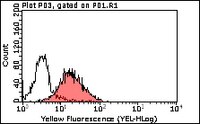MABF62 Sigma-AldrichAnti-Tim3 Antibody, clone 2E2
Anti-Tim3 Antibody, clone 2E2 detects level of Tim3 & has been published & validated for use in WB, FC.
More>> Anti-Tim3 Antibody, clone 2E2 detects level of Tim3 & has been published & validated for use in WB, FC. Less<<Productos recomendados
Descripción
| Replacement Information |
|---|
Tabla espec. clave
| Species Reactivity | Key Applications | Host | Format | Antibody Type |
|---|---|---|---|---|
| H | WB, FC | M | Purified | Monoclonal Antibody |
| References |
|---|
| Product Information | |
|---|---|
| Format | Purified |
| Control |
|
| Presentation | Purified mouse monoclonal IgG1κ in buffer containing 0.1 M Tris-Glycine (pH 7.4), 150 mM NaCl with 0.05% sodium azide. |
| Quality Level | MQ100 |
| Physicochemical Information |
|---|
| Dimensions |
|---|
| Materials Information |
|---|
| Toxicological Information |
|---|
| Safety Information according to GHS |
|---|
| Safety Information |
|---|
| Storage and Shipping Information | |
|---|---|
| Storage Conditions | Stable for 1 year at 2-8°C from date of receipt. |
| Packaging Information | |
|---|---|
| Material Size | 100 µL |
| Transport Information |
|---|
| Supplemental Information |
|---|
| Specifications |
|---|
| Global Trade Item Number | |
|---|---|
| Número de referencia | GTIN |
| MABF62 | 04053252591327 |
Documentation
Anti-Tim3 Antibody, clone 2E2 Ficha datos de seguridad (MSDS)
| Título |
|---|
Anti-Tim3 Antibody, clone 2E2 Certificados de análisis
| Cargo | Número de lote |
|---|---|
| Anti-Tim3, clone 2E2 - 2373432 | 2373432 |
| Anti-Tim3, clone 2E2 - 2394109 | 2394109 |
| Anti-Tim3, clone 2E2 - 2420526 | 2420526 |
| Anti-Tim3, clone 2E2 - 2318833 | 2318833 |
| Anti-Tim3, clone 2E2 - 2505471 | 2505471 |
| Anti-Tim3, clone 2E2 - 2906340 | 2906340 |
| Anti-Tim3, clone 2E2 - 3532430 | 3532430 |
| Anti-Tim3, clone 2E2 - 4191167 | 4191167 |
| Anti-Tim3, clone 2E2 - NRG1906479 | NRG1906479 |
| Anti-Tim3, clone 2E2 -2527586 | 2527586 |
Referencias bibliográficas
| Visión general referencias | Pub Med ID |
|---|---|
| Validation and comparison of tumor-associated trypsin inhibitor (TATI) immunoassays. Elisabete Janeiro,Joana Guimarães,Ulf-Håkan Stenman,Manuela Catarino,Outi Itkonen,Joana Guimar,Ulf-H Stenman Clinica chimica acta; international journal of clinical chemistry 413 2011 Mostrar resumen | 22507084
 |








